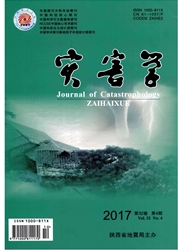

 中文摘要:
中文摘要:
自然灾害风险评估是综合灾害风险管理的关键途径,而评估方法又是灾害风险评估的关键。总结了近年来3个重要的自然灾害风险评估国际计划:灾害风险指标计划(DRI)、多发展指标计划(Hotspots)和美洲计划的(American Programme)分析单元、灾种选择和数据源。评述了3个国际计划采用的数据处理方法、模型和评估方法:计算DRI的指标需计算3个数值——物质暴露、相对脆弱性和社会-经济脆弱性指标;Hotspots首次利用栅格单元和地区/财富等级来计算死亡风险和经济损失风险;美洲计划分别建立了4个独立指标的计算模型,并应用到城市级别。通过比较3个国际计划的风险评估方法的优点与不足,提出了今后灾害风险评估的重点和关键应是风险的时空分布、动态风险评估和案例研究。关键词:灾害风险指标计划;多发区指标计划;美洲计划;评估方法;灾害风险
 英文摘要:
英文摘要:
Natural disaster risk assessment is a key method to integrated disaster risk management. This paper summarizes the analytical units, hazard types and main data sources of three important international programs: DRI, Hotspots and American Program that were developed and carried out for natural disaster risk assessment in recent years. The data processing measures, calculation models and detailed assessment methods of the three international programs are reviewed. Calculation of DRI's indicators includes three steps: calculation of physical exposure, relative vulnerability and vulnerability indicators. For the first time Hotspots utilized grid cells and region/wealth classes to calculate death risk and economic loss risk. American Program developed four independent indicators' models respectively, and applied at city level as well. We suggest that the future disaster risk assessment should be focused on risk temporal and spatial variability, dynamic risk assessment and case study through comparing the advantages and weaknesses between the three natural disaster risk assessment international programs.
 同期刊论文项目
同期刊论文项目
 同项目期刊论文
同项目期刊论文
 Summer-time Denitrification and Nitrous Oxide exchange in the intertidal zone of the Yangtze Estuary
Summer-time Denitrification and Nitrous Oxide exchange in the intertidal zone of the Yangtze Estuary Evaluation of Dissolved Inorganic Nitrogen Eliminating Capability of the Sediment in the Tidal Wetla
Evaluation of Dissolved Inorganic Nitrogen Eliminating Capability of the Sediment in the Tidal Wetla Monitoring urban expansion and land use/land cover changes of Shanghai metropolitan area during tran
Monitoring urban expansion and land use/land cover changes of Shanghai metropolitan area during tran Waterlogging risk assessment based on land use/cover change: a case study in Pudong New Area, Shangh
Waterlogging risk assessment based on land use/cover change: a case study in Pudong New Area, Shangh Initialization strategies to enhancing the performance of genetic algorithms for the p-median proble
Initialization strategies to enhancing the performance of genetic algorithms for the p-median proble A spatial approach to select pilot counties for programs to correct the biased sex ratio at birth in
A spatial approach to select pilot counties for programs to correct the biased sex ratio at birth in Cross-shore suspended sediment flux in the salt marsh pioneer zone of Chongming eastern beach in the
Cross-shore suspended sediment flux in the salt marsh pioneer zone of Chongming eastern beach in the 期刊信息
期刊信息
